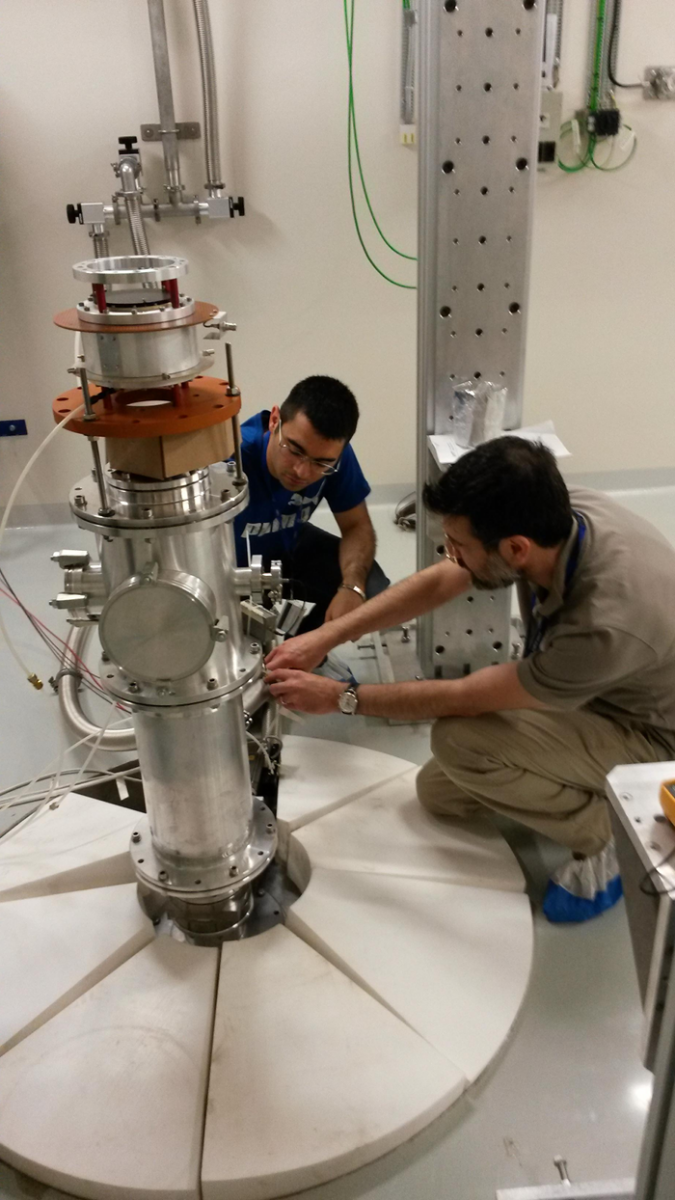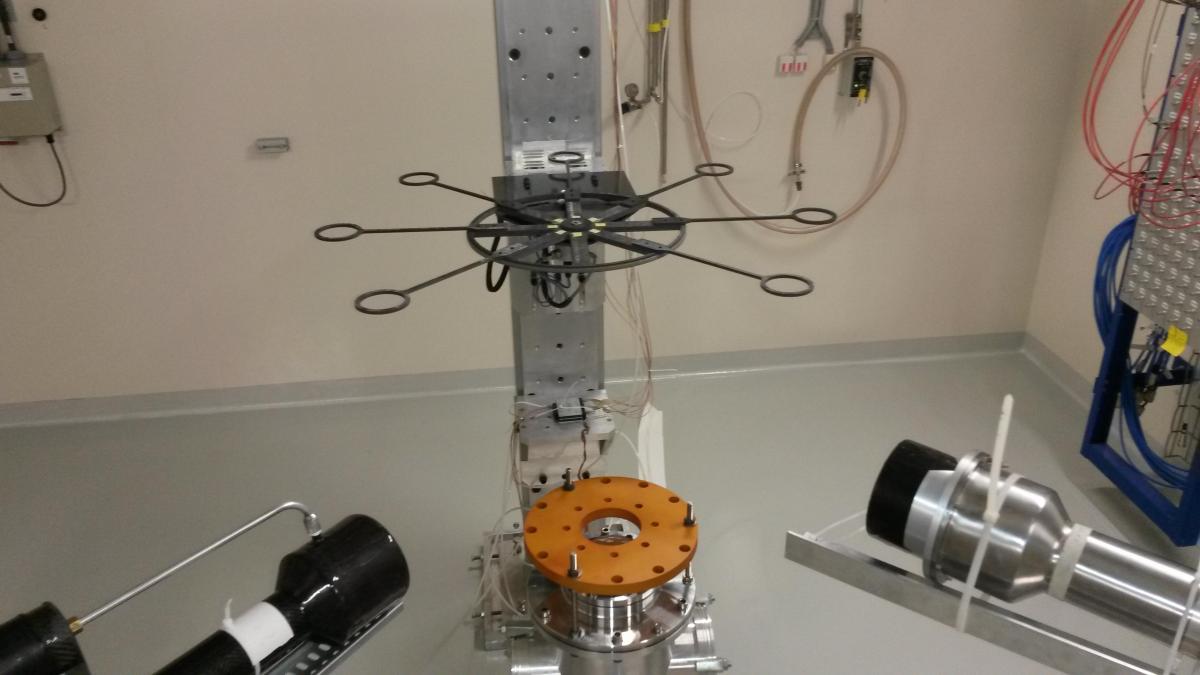A bright future for neutrons at n_TOF
After the long shutdown, the newly constructed second experimental area (EAR2) [1] of the n_TOF facility has received its first neutron beam on July 25 2014 [2]. The neutron beam in EAR2 complements, and runs in parallel with, the existing experimental area EAR1.
The story of CERN’s neutron time-of-flight facility n_TOF goes at least back to 1998 when Rubbia et al. [3] proposed the idea of a neutron facility, which eventually became fully operational in 2001. At the occasion of a first major upgrade, the old spallation target was removed and replaced by a new target with an optimized design and a decoupled cooling and moderation circuit, allowing the use of borated water in order to reduce the background due to in-beam hydrogen capture gamma rays. A second improvement was the construction of a long-awaited class A work sector, which made it possible to use unsealed, but nevertheless encapsulated, radioactive isotopes for the measurements in the experimental area. The facility was again operational in 2008 until the long shutdown in the beginning of 2013. An overview of the performance of the facility and related references can be found in ref. [4].

Fig.1 The new building 380 hosting n_TOF EAR2 (picture Ch. Weiss)
Neutron-induced reaction cross sections as measured at n_TOF play an important role in a wide variety of research fields, ranging from stellar nucleosynthesis [5,6], the investigation of nuclear level density studies [7], to applications of nuclear technology, including for medical applications, the transmutation of nuclear waste, accelerator driven systems and nuclear fuel cycle investigations [8,9].
The neutron time-of-flight facility n_TOF at CERN is used to produce pulsed neutron beams using the proton beam from the PS. The pulsed proton beam impinges on a 60 cm long by 40 cm diameter cylindrical lead spallation target and yields about 300 neutrons per incident proton. A typical proton pulse contains 7x1012 protons. A layer of water of in total about 5 cm moderates the initially fast neutrons, resulting in a broad range of neutron energies spanning a range of exploitable kinetic energies from meV to several hundreds of MeV. The neutrons are collimated and guided through an evacuated beam tube to the experimental area, located horizontally at approximately 185 m from the spallation target for EAR1, and vertically at approximately 20 m for EAR2. In the experimental area various combinations of samples and detectors can be installed to measure the reaction products of neutron-induced reactions. By measuring the flight time of the neutrons over the known flight path, the kinetic energy of the incident neutrons can be determined.

Fig.2 Several neutron-induced reaction cross sections for a typical heavy nucleus as a function of the neutron kinetic energy.
In figure 2, typical cross sections for neutron-induced reactions on a heavy nucleus are shown as a function of the neutron kinetic energy. One of the most striking features of neutron-nucleus interactions is the resonance structure observed in the reaction cross sections at low incident neutron energies. Since the electrically neutral neutron has no Coulomb barrier to overcome, and has a negligible interaction with the electrons in matter, it can directly penetrate and interact with the atomic nucleus, even at very low kinetic energies in the order of electron-volts. The cross sections can show variations of several orders of magnitude on an energy scale of only a few eV. The origin of the resonances is well understood. They are related to the excitation of nuclear states in the compound nuclear system formed by the neutron and the target nucleus, at excitation energies lying above the neutron binding energy of typically several MeV.
The wide neutron energy range is one of the key features of the n_TOF facility. Another unique characteristic of n_TOF is the very high number of neutrons per proton burst, also called instantaneous neutron flux. In the case of radioactive samples in the neutron beam, this results in a very favorable ratio between the number of signals due to neutron-induced reactions and those due to radioactive decay events, which contribute to the background. The longer the flight path is, the larger is the time window onto which the range of kinetic energies of the neutrons is mapped, and consequently the better structures in the energy spectrum can be resolved. On the other hand, a longer flight path means a longer distance from the source of neutrons, the spallation target, and therefore a lower neutron flux at the end of the flight path. While the long flight path of EAR1 results to a very high kinetic energy resolution, the short flight path of EAR2 leads to a neutron flux which is even higher than that of EAR1, by a factor of about 25. This opens the possibility for measurements on nuclei with very low mass or low reaction cross sections, and especially for experiments with highly radioactive nuclei. A higher instantaneous neutron flux results in a higher number of useful events in a given time-of-flight bin, while the contribution of background events from radioactivity stays the same.

Fig 3. Mounting detectors in EAR2 [2].
The measurement of neutron-induced reaction cross sections is one of the major goals of the n_TOF collaboration. Reaching this goal goes together with a continuous development of detectors and analysis techniques, the design of feasible experiments and training of a new generation of physicists working in neutron physics. Sample preparation is an increasingly important topic that needs to be addressed. In order to preserve the measured data for the future, a close collaboration with the community of experimental and evaluated nuclear data libraries is mandatory.

Fig 4. Configuration of the vertical beam line in EAR2 with a sample exchanger and two liquid scintillator detectors in a preliminary setup.
The present achievement of the final construction of EAR2 after a period of design and construction marks the start of a third phase of data taking at n_TOF, allowing to push the limits of feasibility of neutron induced reaction measurements. The ongoing commissioning aims at measuring and validating its characteristics in terms of flux, beam profile and backgrounds and making a detailed comparison between the two experimental areas EAR1 and EAR2. Every measurement needs to be carefully evaluated in order to take advantage either of the very high instantaneous flux in EAR2, or the very high resolution in EAR1. Accepted and upcoming proposals to the INTC for EAR2 are therefore focused on cross-section measurements with highly radioactive nuclei.
Notes:
[1] E. Chiaveri et al., Proposal for n_TOF Experimental Area 2, CERN-INTC-2011-032
[2] A. Del Rosso, CERN Bulletin 2014-07-29, http://cds.cern.ch/record/1746358?ln=en
[3] C.Rubbia,etal.,Ahighresolutionspallationdriven facility at the CERN-PS to measure neutron cross-sections in the interval from 1 eV to 250 MeV; CERN/LHC/98-02, 1998.
[4]C. Guerrero et al, Performance of the neutron time-of-flight facility n TOF at CERN, Eur. Phys. J. A49 (2013) 27
[5] F. Käppeler et al.,Rev. Mod. Phys. 83 (2011) 157
[6] T. Rauscher, AipAdvances 4 (2014) 041012
[7] H. A. Weidenmuller et al.,Rev. Mod. Phys. 83 (2011) 157
[8] G. Aliberti et al.,Nucl. Sci. Eng. 146 (2004) 13
[9] A. Nuttin et al., Ann. Nucl. Energy 40(2012) 171
